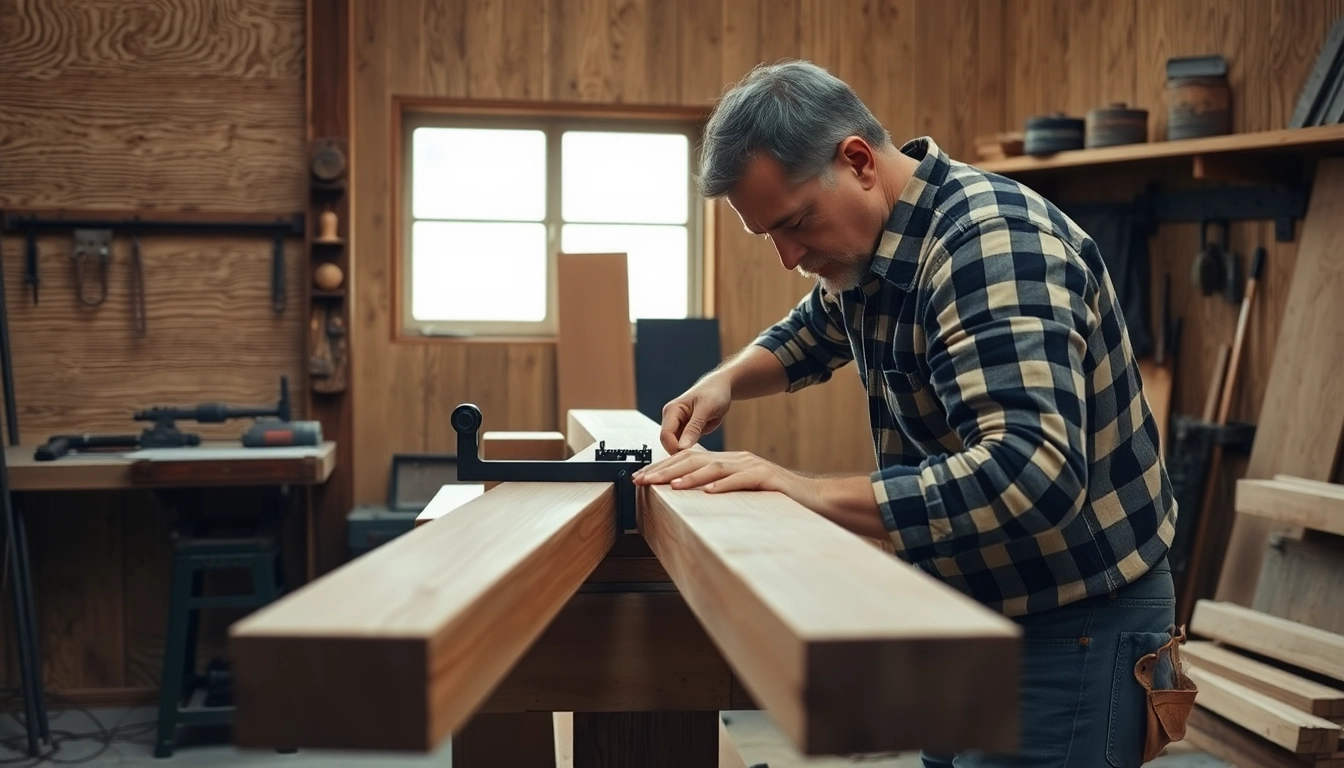Understanding Carpentry: Definition and Scope
What is Carpentry? Overview and Core Skills
Carpentry is a foundational trade within the construction and woodworking industries, encompassing the skilled craft of cutting, shaping, installing, and repairing building materials, primarily wood, but also including other materials like metals, plastics, and composite products. At its core, carpentry involves transforming raw materials into functional structures, intricate detailed joinery, or aesthetic finishes that enhance the usability and beauty of a space. This profession combines technical skill, artistic eye, and precise craftsmanship to produce everything from residential frameworks to intricate decorative woodwork.
For those exploring a career or project involving carpentry, it’s essential to understand its broad scope—ranging from rough framing to detailed finish carpentry. Whether constructing the frame of a skyscraper or crafting custom cabinetry, core skills include proficiency with hand and power tools, understanding structural design principles, and adhering to safety standards. Anyone delving into this craft should prioritize mastery in measurement, cutting, joinery, and installation techniques.
To get a comprehensive understanding of what carpentry entails, consider the critical skills required: accurate measurement, precise cutting, adept joinery, and the ability to read and interpret blueprints. These skills form the backbone of effective craftsmanship, ensuring the finished work is both structurally sound and visually appealing. Additionally, adaptability to various project types—residential, commercial, or specialized—demands continuous learning and mastery of diverse techniques.
Types of Carpentry Work: Residential, Commercial, and Specialized Projects
Carpentry is a versatile trade that spans multiple sectors, each demanding unique skills and specializations. Broadly, carpenters categorize their work into residential, commercial, and specialized trades, each with distinct characteristics, project scopes, and skill requirements.
Residential Carpentry
Residential carpentry focuses on constructing, remodeling, and finishing homes—single-family houses, multi-family units, and apartments. It includes tasks such as framing walls, installing windows and doors, building staircases, and executing detailed interior finish work like cabinetry, crown molding, and flooring. This sector often emphasizes craftsmanship finesse, aesthetics, and efficiency, aiming to deliver attractive and functional living spaces.
Commercial Carpentry
Commercial projects encompass larger-scale endeavors such as office buildings, retail centers, schools, hospitals, and warehouses. Here, carpenters work with larger structures, often following stricter codes and safety protocols. Techniques might involve heavy framing, scaffold use, and integrating specialized systems such as HVAC, electrical, or fire suppression components. The complexity and scale of these projects call for advanced planning, coordination, and sometimes supervisory roles.
Specialized Projects
Beyond basic framing, specialized carpentry includes millwork, cabinetry, furniture making, stained glass framing, and restoration work. It often requires a high degree of artistic skill and technical knowledge. For example, finish carpenters craft custom staircases or intricate wood trim, while heritage restorers focus on preserving historical structures’ authenticity. Advanced techniques, precision tools, and creative problem-solving underpin successful execution in these niches.
Recognizing the diversity within carpentry disciplines helps aspiring carpenters and clients understand project expectations and scope. Whether building the basic framework of a new home or creating bespoke wooden fixtures, specialization allows craftsmen to develop mastery and command premium skills in their chosen field.
The History and Evolution of Carpentry Trades
The craft of carpentry is among the oldest trades, dating back thousands of years—initially managing survival needs such as shelter, tools, and transportation. Ancient civilizations like the Egyptians, Romans, and Chinese demonstrated sophisticated carpentry techniques, from temple construction to maritime shipbuilding.
Over centuries, carpentry evolved from primitive timber framing to complex structural systems, incorporating innovations like nails, saws, and eventually, power tools. The Industrial Revolution marked a significant turning point, enabling mass production and enhanced precision. Today, digital design tools like CAD (Computer-Aided Design) further transform how carpenters plan and execute projects.
Historically, carpentry was a family craft, often passed down through generations. Modern techniques, codes, and safety standards now govern the trade, necessitating formal training and certifications. Despite technological advancements, the essential craftsmanship—precision, patience, and attention to detail—remains unchanged, connecting modern carpenters to a rich legacy of craftsmanship.
The evolution continues with emerging trends such as modular construction, green building practices, and automation. The integration of sustainable materials and advanced software further broadens the scope of what carpenters can produce, ensuring this age-old craft remains vital and adaptable.
Key Carpentry Techniques and Best Practices
Fundamental Tools Every Carpenter Should Know
Mastery of essential tools forms the foundation of effective carpentry. Basic hand tools include tape measures, levels, squares, chisels, saws, and hammers. Power tools such as drills, circular saws, jigsaws, and routers significantly increase efficiency and precision. Modern carpenters also utilize pneumatic nail guns, oscillating multi-tools, and laser levels for accuracy.
Correct tool maintenance, safety protocols, and proper technique are crucial to prevent accidents and extend equipment lifespan. For example, maintaining sharp blades improves cut quality, while wearing appropriate personal protective equipment (PPE) minimizes workplace hazards.
Measuring, Cutting, and Joining: Precision in Carpentry
Precision measurement is vital; inaccuracies can lead to structural issues or aesthetic flaws. Skilled carpenters rely on tools such as tape measures, laser distance meters, and marking gauges. Learning to read blueprints and technical drawings accurately ensures correct dimensions and placement.
Cutting techniques vary depending on the material and project. Straight cuts with circular saws, curved cuts with jigsaws, and precise joinery like dovetails and mortise-and-tenon enhance the strength and appearance of finished work. The quality of joints determines structural integrity and visual appeal—well-executed joints like half-laps, box joints, and dowel joints are hallmarks of professionalism.
Advanced carpentry emphasizes layouts and joinery techniques that maximize material efficiency and stability. Sanding, finishing, and fitting are the final steps to ensure smoothness and functionality.
Designing and Planning Carpentry Projects Effectively
Planning is the cornerstone of successful carpentry projects. Effective design begins with comprehensive drawings, specifications, and material lists. Modern software tools facilitate 3D modeling and construction simulations, enabling visualization before physical work starts.
Critical planning factors include material selection, load requirements, safety measures, and timeline management. With detailed planning, carpenters can identify potential issues early, reducing waste and delays. Incorporating client preferences and functional needs ensures the final product meets expectations.
Collaboration with architects, engineers, and clients fosters clear communication, aligning technical feasibility with aesthetic goals. A well-crafted plan translates technical details into practical, buildable steps, minimizing errors and maximizing quality.
Training, Careers, and Growing in the Carpentry Field
Educational Pathways and Certification Opportunities
Aspiring carpenters can pursue various educational routes, ranging from high school vocational programs to college degrees. Many technical schools and community colleges offer comprehensive carpentry programs, often culminating in certificates or associate degrees. Such programs cover essential skills—measurements, blueprint reading, tool handling, safety, and building codes—as well as specialization options like finish carpentry or framing.
Certification from recognized industry organizations, such as the National Association of Home Builders (NAHB) or OSHA safety certifications, enhances employability and credibility. Apprenticeship programs combining classroom instruction with on-the-job training provide invaluable practical experience, often leading to journeyman status.
Continuous education, attending workshops, and staying current with industry standards, tools, and best practices are crucial for long-term career growth in carpentry.
Building a Successful Carpentry Career: Tips and Insights
Success in carpentry hinges on technical expertise, reliability, effective communication, and a strong work ethic. Developing a portfolio of completed projects, building good relationships with clients and contractors, and embracing continuous learning are key strategies.
Networking through industry associations and online platforms helps carpenters stay connected with new opportunities and trends. Specializing in high-demand niches—such as custom cabinetry, historic restoration, or green building—can command premium rates and foster a reputation for excellence.
Entrepreneurial carpenters consider establishing their own business, which requires skills in project management, marketing, and financial planning. Building a brand through quality work, punctuality, and customer satisfaction ensures sustainable growth.
Emerging Trends and Specializations in Carpentry
The carpentry industry is evolving with innovations like sustainable building practices, eco-friendly materials, and modular construction. Advanced tools, including CNC (Computer Numerical Control) machines and robotic assistants, are expanding possibilities for precision and efficiency.
Trends toward energy-efficient homes and smart buildings drive demand for specialized skills in integrating electrical and HVAC systems into wooden frameworks. Additionally, the rise of 3D modeling and digital fabrication allows more complex and customized projects.
Opportunities also exist in niche areas such as artisanal furniture, historical preservation, and environmentally conscious building design—each requiring a blend of traditional craftsmanship and modern innovation.
Starting Your Carpentry Project: Step-by-Step Guide
Preparing Materials and Workspace
Successful carpentry projects begin with meticulous preparation. Selecting appropriate materials—whether different types of wood, metal fasteners, or finishing supplies—is essential. Understanding material properties (such as moisture content and strength) informs proper handling and storage.
Workspace setup involves ensuring a clean, well-lit, and safe environment. Organizing tools and materials reduces waste and improves workflow. For projects involving complex cuts or assemblies, establishing reference points and using jigs or guides enhances accuracy.
Executing the Construction Process Efficiently
Implementation involves following the detailed plan, beginning with foundational steps like marking and cutting, followed by assembly. Adherence to safety protocols, including PPE and proper tool use, is paramount. Maintaining consistent quality control throughout the process helps catch errors early.
Utilizing advanced techniques like clamp-and-glue assembly or pre-finished components can speed up production without compromising quality. Time management and effective communication with team members or clients improve productivity and satisfaction.
Finishing Touches and Ensuring Quality Standards
Finishing involves sanding, sealing, staining, and applying protective coatings to achieve the desired aesthetic and durability. Attention to detail during finishing ensures smooth surfaces and proper fitment of hardware.
Inspection against project specifications guarantees quality. Addressing minor imperfections promptly maintains high standards. Final installation and cleanup complete the project, ready to be appreciated by clients or future users.
Measuring Success: Tools, Metrics, and Customer Satisfaction
Utilizing Software and Modern Equipment
Modern carpenters leverage software like CAD and project management tools to increase precision and efficiency. Digital measurement devices, laser levels, and 3D scanners improve accuracy and streamline workflows.
Equipment advancements, such as cordless power tools with longer battery life and ergonomic designs, reduce fatigue and enhance productivity. Incorporating modern technology into daily practice ensures competitiveness and quality.
Client Communication and Project Management
Clear communication with clients is critical. Regular updates, transparent costing, and understanding client needs foster trust and repeat business. Using digital tools like project timelines and photo documentation helps in managing expectations.
Strong project management practices—such as setting realistic deadlines, tracking progress, and managing unexpected delays—are vital. Employing collaborative platforms facilitates coordination among team members and stakeholders.
Evaluating Project Outcomes and Learning Continuous Improvement
Post-project review, including client feedback and self-assessment, helps identify areas for improvement. Maintaining detailed records of work processes and challenges guides future projects. Emphasizing continuous learning through courses, industry updates, and skill enhancement sustains professional growth.
Metrics such as project completion time, cost adherence, and client satisfaction scores serve as benchmarks for success.



